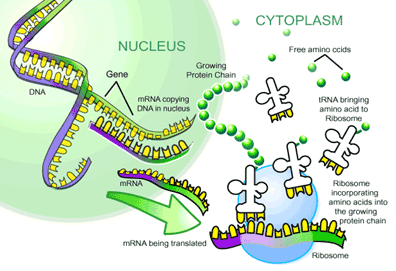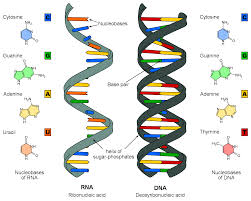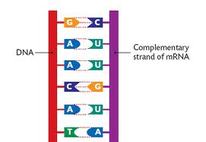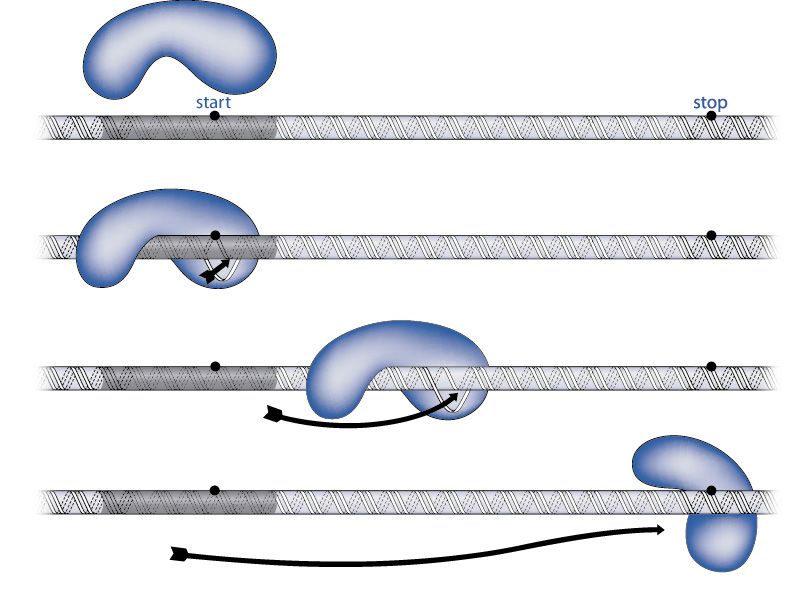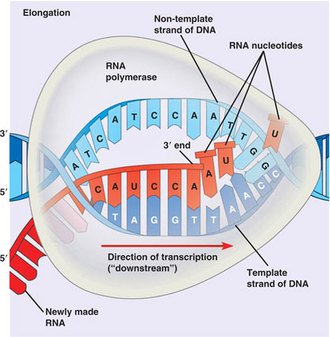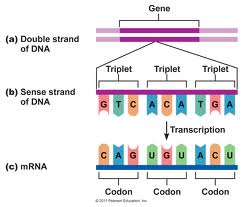| Transcription Overview
| Click image to be taken to the source. |
| DNA vs. RNA DNA contains genetic information while RNA translate the it into a code to produce proteins. DNA molecules are in a spiral while a RNA is a single strand of nucleotides. | Messenger RNA (mRNA) Messenger RNA is a single strand of RNA that provides a template for protein synthesis. The strand is complementary to a DNA strand of a gene. The mRNA codes for amino acid sequences. It also matches up complementary bases during elongation. | RNA Polymerase RNA polymerase is the enzyme, composed of multiple proteins, that creates RNA from a DNA template. In order to copy the information correctly, it proof reads the code as the RNA strand is being created. |
| ATP The reduction of ATP into ADP creates the energy needed to start transcription. Transcription Unit The transcription unit is the largest piece of DNA and is used as the area that produces RNA. | Transcription Factors Transcription factors are responsible for recruiting RNA polymerase during the beginning of transcription. They are proteins that bind to DNA to control which genes are turned off and on in the genome. The proteins can help or stop the enzyme that controls the transcription. | TATA Box and Enhancer Region The TATA box, found in the promoter of most genes, indicates where a genetic sequence can be read. The enhancer region is found at a distance away from the promoter. Once they are bound they interact to alter the transcription time. |
| Process of Transcription Transcription provides a copy of genetic code for to prepare for translation. It begins with the DNA and takes place in the nucleus. 1. Initiation: RNA polymerase attaches to a promoter in DNA and begins to build mRNA. Transcription starts at the starting point of the promoter where the RNA polymerase begins RNA synthesis. To produce RNA or the "antisense strand", only one DNA strand or otherwise known as the "sense strand". 2. Elongation: DNA strand splits open and RNA nucleotides add to DNA. RNA polymerase is needed in order to assemble individual RNA nucleotides. Nucleotides are added to the 3' end of the polynucleotide chain. IT creates a short stretch of single stranded DNA. As more nucleotides are being added, the mRNA grows longer. 3. Termination: The mRNA detaches from the gene. As it nears the ending point, the terminator signals the end of transcription and releases the RNA polymerase. The polymerase then starts the process of transcription on another DNA strand. | Complementary Bases DNA provides the instructions to create RNA and contains the nucleotides adenine, thymine, guanine and cytosine. The mRNA is an RNA copy of DNA that will later be coded for a protein. It contains the the nucleotides adenine, uracil, guanine and cytosine.
|
Helpful Videos
| The following video simplifies the process of initiation, elongation and termination in transcription. | The following video pays special attention to the necessary parts during the initiation process. |
